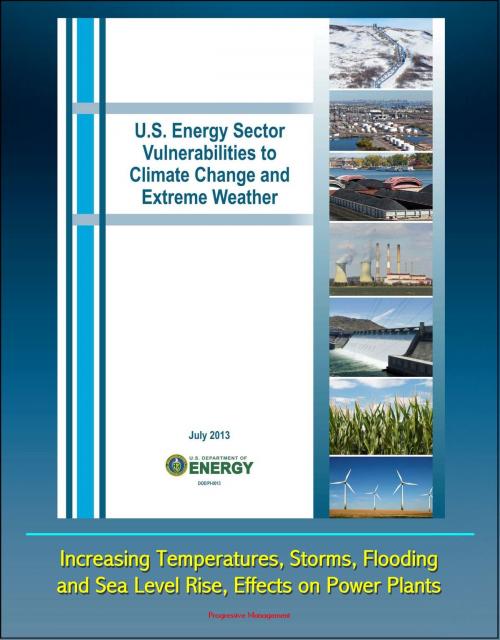U.S. Energy Sector Vulnerabilities to Climate Change and Extreme Weather: Increasing Temperatures, Storms, Flooding, and Sea Level Rise, Effects on Power Plants
Nonfiction, Science & Nature, Technology, Power Resources, Science, Earth Sciences| Author: | Progressive Management | ISBN: | 9781301994946 |
| Publisher: | Progressive Management | Publication: | July 14, 2013 |
| Imprint: | Smashwords Edition | Language: | English |
| Author: | Progressive Management |
| ISBN: | 9781301994946 |
| Publisher: | Progressive Management |
| Publication: | July 14, 2013 |
| Imprint: | Smashwords Edition |
| Language: | English |
At least three major climate trends are relevant to the energy sector: increasing air and water temperatures, decreasing water availability in some regions and seasons, and increasing intensity and frequency of storm events, flooding, and sea level rise. This report — part of the Administration's efforts to support national climate change adaptation planning through the Interagency Climate Change Adaptation Task Force and Strategic Sustainability Planning process established under Executive Order 13514 and to advance the U.S. Department of Energy's goal of promoting energy security — examines current and potential future impacts of these climate trends on the U.S. energy sector. It identifies activities underway to address these challenges and discusses potential opportunities to enhance energy technologies that are more climate-resilient, as well as information, stakeholder engagement, and policies and strategies to further enable their deployment.
Increasing temperatures, decreasing water availability, more intense storm events, and sea level rise will each independently, and in some cases in combination, affect the ability of the United States to produce and transmit electricity from fossil, nuclear, and existing and emerging renewable energy sources. These changes are also projected to affect the nation's demand for energy and its ability to access, produce, and distribute oil and natural gas (ORNL 2012a, USGCRP 2009). An assessment of impacts—both positive and negative—is necessary to inform forward-looking efforts to enhance energy security. Significant findings include:
• Thermoelectric power generation facilities are at risk from decreasing water availability and increasing ambient air and water temperatures, which reduce the efficiency of cooling, increase the likelihood of exceeding water thermal intake or effluent limits that protect local ecology, and increase the risk of partial or full shutdowns of generation facilities
• Energy infrastructure located along the coast is at risk from sea level rise, increasing intensity of storms, and higher storm surge and flooding, potentially disrupting oil and gas production, refining, and distribution, as well as electricity generation and distribution
• Oil and gas production, including unconventional oil and gas production (which constitutes an expanding share of the nation's energy supply) is vulnerable to decreasing water availability given the volumes of water required for enhanced oil recovery, hydraulic fracturing, and refining
At least three major climate trends are relevant to the energy sector: increasing air and water temperatures, decreasing water availability in some regions and seasons, and increasing intensity and frequency of storm events, flooding, and sea level rise. This report — part of the Administration's efforts to support national climate change adaptation planning through the Interagency Climate Change Adaptation Task Force and Strategic Sustainability Planning process established under Executive Order 13514 and to advance the U.S. Department of Energy's goal of promoting energy security — examines current and potential future impacts of these climate trends on the U.S. energy sector. It identifies activities underway to address these challenges and discusses potential opportunities to enhance energy technologies that are more climate-resilient, as well as information, stakeholder engagement, and policies and strategies to further enable their deployment.
Increasing temperatures, decreasing water availability, more intense storm events, and sea level rise will each independently, and in some cases in combination, affect the ability of the United States to produce and transmit electricity from fossil, nuclear, and existing and emerging renewable energy sources. These changes are also projected to affect the nation's demand for energy and its ability to access, produce, and distribute oil and natural gas (ORNL 2012a, USGCRP 2009). An assessment of impacts—both positive and negative—is necessary to inform forward-looking efforts to enhance energy security. Significant findings include:
• Thermoelectric power generation facilities are at risk from decreasing water availability and increasing ambient air and water temperatures, which reduce the efficiency of cooling, increase the likelihood of exceeding water thermal intake or effluent limits that protect local ecology, and increase the risk of partial or full shutdowns of generation facilities
• Energy infrastructure located along the coast is at risk from sea level rise, increasing intensity of storms, and higher storm surge and flooding, potentially disrupting oil and gas production, refining, and distribution, as well as electricity generation and distribution
• Oil and gas production, including unconventional oil and gas production (which constitutes an expanding share of the nation's energy supply) is vulnerable to decreasing water availability given the volumes of water required for enhanced oil recovery, hydraulic fracturing, and refining















